Sculptures in the Streets 2024
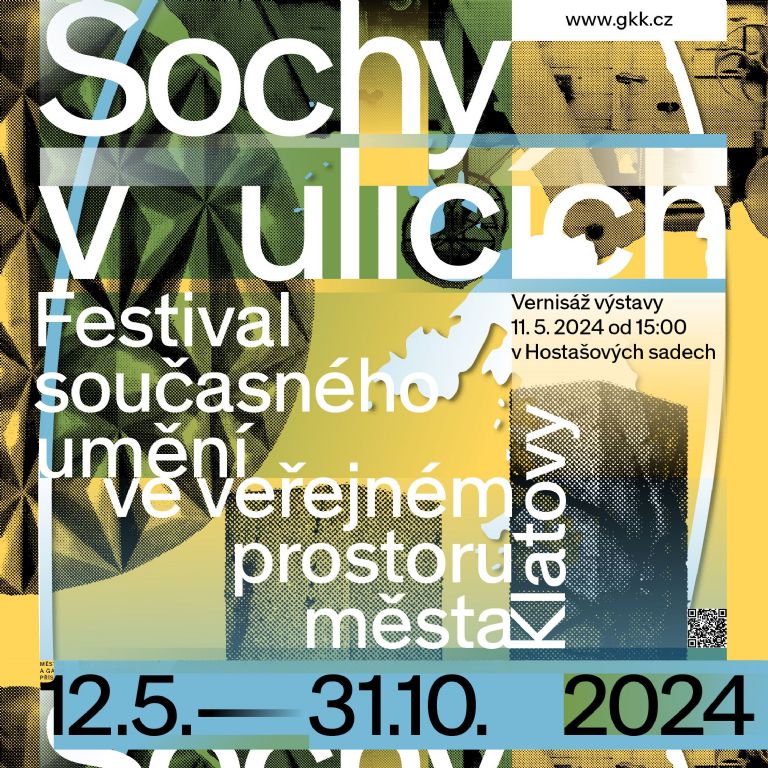
02.05.2024
Sculptures in the StreetsKlatovy
12. 5. - 31. 10. 2024
A festival of contemporary art in the public spaces of the town of Klatovy
Exhibiting artists
Pavel Hošek, Monika Immrová, Zuzana Kačerová, Kryštof Kaplan, Jiří Kobr, Jakub Lipavský, Luděk Míšek, Petra Pešková, Lucie Píštělková, Lucie Procházková, Jindřich Zeithamml
Curators: Zuzana Kantová, Petr Krátký
Graphic design of exhibition and promotional materials: Matěj Moravec
Exhibition opening: Saturday, 11 May 2024, at 3pm in Klatovy’s Hostašovy Sady, including guided tour of the exhibition with the curators and the participating artists; 4:30pm refreshments at the Vlaštovka bistro, Vančurova 53, 339 01 Klatovy, followed by 5pm concert by Klatovy crossover-indie group MRKLM.
The Klatovy/Klenová Gallery, in collaboration with the City of Klatovy and with financial support from the Czech Ministry of Culture, presents Sculptures in the Streets – the third instalment of the gallery’s festival of contemporary art in the public space of the city.
For this exhibition, we have chosen eleven locations in the historic city center or the nearby environs, where the various works of art will enrich Klatovy’s urban landscape for a period of six months.
This year’s edition once again reflects the organizer’s long-standing aim to, once a year, offer the public a different perspective on the subject of art in the urban landscape and to collaborate with leading sculptors and their students to present distinctive views on the question of public sculpture.
The exhibited works are by graduates of the Sculpture 2 studio at Prague’s Academy of Fine Arts, which in 1995–2016 was headed by the sculptor Jindřich Zeithamml. Zeithamml’s studio was focused on abstract sculpture in the spirit of sculpture in the original meaning of the word – i.e., as a means of expressing oneself through substance, form, and their mutual interaction. One of the studio’s important characteristics under Zeithamml’s direction was an understanding of the sculpture as a chance for artistic expression involving work with the physical material, while remaining aware of canon and the rules of proportionality. The traditional approach to sculpture is here understood as a still-valid foundation that can at any time serve as a source of support for experimental searching.
The choice of artists has been made with a view to presenting the full range of approaches found among the graduates of this unique sculptural course.
Our goal with this project is offer residents of and visitors to Klatovy an unusual experience as they encounter works of art in the city’s cultural landscape. In this way, we hope to present them with new and unusual impulses for thinking about the place in which we live. Our ongoing work with the city’s public space as part of this annual festival also offers inspiration for critically reflecting on the relationships within the urban space and helps to highlight various issues that might seem daunting when approached in a more traditional manner (socially excluded localities, public amenities, street furniture, social interconnections, environmental issues, etc.).
The works of art have been provided on loan by the artists free of charge. Thanks to funding from a variety of sources, the project is sustainable in the long term. The exhibition is freely accessible throughout its duration.
As during last year’s exhibition, spectators may vote for the best sculpture in a survey on the exhibition’s Facebook profile. The winning artist and one of the voters, drawn in a lottery, win free admission to the Klatovy/Klenová Gallery in 2025.
Pavel Hošek (*1976, Zlín) is a Czech sculptor. He studied sculpture at the Secondary School of Applied Art in Uherské Hradiště in 1991–1995 and at Prague’s Academy of Fine Arts in 1995–2001, where he attended professor Jindřich Zeithamml’s Sculpture 2 studio and was twice awarded the Studio Award (1997 and 2000). In 1999, he did a study exchange at the Staatliche Akademie der Bildenden Künste in Karlsruhe, and in 2003 he was artist-in-residence at the Egon Schiele Art Centrum in Český Krumlov. In his art, Hošekexplores the process and possibilities of dematerializing space or a structurally clearly defined spatial core. He applies geometric elements and their compositional qualities with the aim of evoking a progressively more complex spatial experience. Elements lose their continuity and become sketched, often incomplete, outlines. His works are explorations of the third dimension, objects hinting at the tension between order and chaos, sometimes kept on a purely abstract level but at other times assigned a specific purpose, which Hošekoften comments on with a thinly veiled sense of irony that lends his objects new connotations of meaning. Hehas exhibited since 1997; he lives and works in Vysoké Mýto.
In Klatovy, Pavel Hošekis showing a work that responds directly to the pedestrian passage underneath Plzeňská Street, which captivated his interest by its distinctive atmosphere. The descent into the illuminated mouth of the tunnel is a compelling experience in and of itself. Working with the qualities of this magical space, his piece climbs the wall by the stairs, all the way up to the surface. Thanks to a subtle, sensitively chosen formal vocabulary, it naturally blends with its surroundings to produce a coherent set of elements whose mutual interaction creates a new quality expressing the physical and mental presence of the viewer.
1. Hoop, 2024, iron
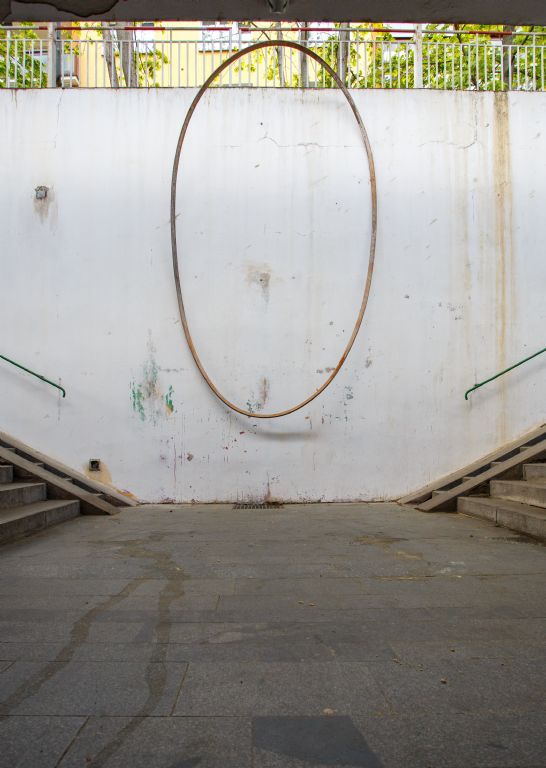
Monika Immrová (*1970, Louny) is a Czech sculptor and printmaker. After attending the Václav Hollar School of Art in Prague in 1992–1995, she continued her studies at the Academy of Fine Arts (1995–2001), from which she later (in 2018) earned her doctoral degree as well. Immrová spent study exchanges at the Staatliche Akademie der Bildenden Künste in Stuttgart in 1997 and at the Hochschule für Bildende Künste in Dresden in 1999–2000; she also did a residency at the Raketenstation Insel Hombroich in Germany in 2011. Her sculptures and graphics reflect life, the vitality of the world, and the human dimension. She works with simple, almost minimalistically economical forms and geometric lines and a reduced color scale that expresses materially symbolic meanings. She clearly draws inspiration from ancient cultures – ancient Egypt, Antiquity, and Mediterranean art. Immrováhas attended sculpture symposia and shown her work at group and solo exhibitions since 1996; she lives and works in Radouš near Beroun.
Monika Immrová’ssculptures and graphics are founded on a minimalist formal vocabulary and work with elementary shapes, volumes, and naturally also light. Her prints span a broad range of stylistic approaches from simple line compositions all the way to spatially illusive and sculpturally voluminous still-lifes. Her graphics cannot be fundamentally separated from her sculptural work; along with reliefs, they form one conceptual and formal whole. Similarly, she explores changing shapes and volumes from the position of a viewer moving within space – as with the work presented at this year’s Sculptures in the Streets. The relief has been installed on the facade of the Baroque house on the corner of Balbínova and Vančurova streets (Vančurova 58). Over the coming years, the building will be renovated as the Josefinum culture center, which will include a museum featuring works of contemporary art from the collections of the Klatovy/Klenová Gallery. Immrová’s piece is thus the first signal of the future of this important Jesuit monument in Klatovy.
2. Outside the Center, 2024, concrete

Zuzana Kačerová (*1982, Prague) is a Czech sculptor and art restorer. She attended the Secondary Technical School of Sculpture and Stonemasonry in Hořice in 1998–2002 before continuing her studies in professor Jindřich Zeithamml’s Sculpture 2 studio at the Academy of Fine Arts in Prague in 2003–2009. During her time at the Academy, she did s study exchange in the school’s Studio of Figure Sculpture (prof. Jan Hendrych) in 2005, plus foreign exchanges at The Cooper Union in New York in 2007 and at Satakunta University in Kankaanpää, Finland, in 2008. In her art, she mainly applies her ability to work with stone. Often, her creative process begins in the quarry with the choice of a suitable block, which she then shapes from raw material into a sophisticated work of art that still respects the stone’s natural shape. Her meticulous working of the surface amplifies the effect of the stone’s natural color, texture, and structure to produce an illusion of soft curves or geometric lines that evoke a multitude of meanings. Kačerová has attended sculpture symposia and shown at solo and group exhibitions in the Czech Republic, Germany, Spain, Italy, Finland, and the United States since 2000; she lives and works in Prague and Hostivice.
The idea behind Zuzana Kačerová’s sculpture presented in Klatovy draws on her previous work and develops her longtime goal of articulating a formal geometric vocabulary within the context of nonrepresentational sculpture as an autonomous form of contemporary artistic expression. The work has been installed in the courtyard of the refectory of the local Jesuit College, where this idea can resonate in a peaceful setting – but also during the many cultural events that are regularly held here in the summer months.
3. Thing, 2024, granite

Kryštof Kaplan (*1987, Prague) is a Czech sculptor and musician. He attended the Secondary Technical School of Sculpture and Stonemasonry in Hořice in 2002–2006 before continuing his studies in professor Jindřich Zeithamml’s Sculpture 2 studio at Prague’s Academy of Fine Arts in 2008–2013, where he subsequently worked as a studio assistant in 2015–2017. Kaplan’s sculptures are characterized by a universally generous use of form and a plasticity based on basic physical laws, usually combined with mechanical construction. He frequently applies an expressivist style, producing psychologically impactful groups of sculptures in which he works with the metaphorical transformation of accumulated tension and with the element of escalated danger. His installations possess a certain theatrical dramaticity. Some of his objects reference parasitical elements of the urban landscape, and his latest works show a tendency towards organic figures. Kaplan is also the frontman for the bands Kaplan Bros. and Vložte kočku, the latter of which won a Vinyla Award in 2013 for Album of the Year, an Anděl Award in 2014 in the category of Electronic Music, and a nomination for the Czech Lion Awards in 2019 for the soundtrack to director Adam Sedlák’s film Domestique. Kryštof Kaplanhas been exhibiting since 2009; he lives and works in the small village of Dobříkovice.
For the duration of the exhibition, Přemysl Otakar II Square will be dominated by a giant zoomorphic object made from an old threshing machine. Kaplan’s artistic intervention, which has given a historical agricultural machine the organic shape of a body, resembles a living organism flowing and expanding out from its shell – like a hermit crab when it outgrows the shell it has occupied, or a chrysalis in which a larva is transformed into a butterfly. Here, the metamorphosis is literally a metaphor for the quiet phase of the dynamic process of artistic creation, which – despite the seemingly unchanging and permanent form of the final work of art – is constantly evolving.
4. Hermit, 2024, steel, wood, resin
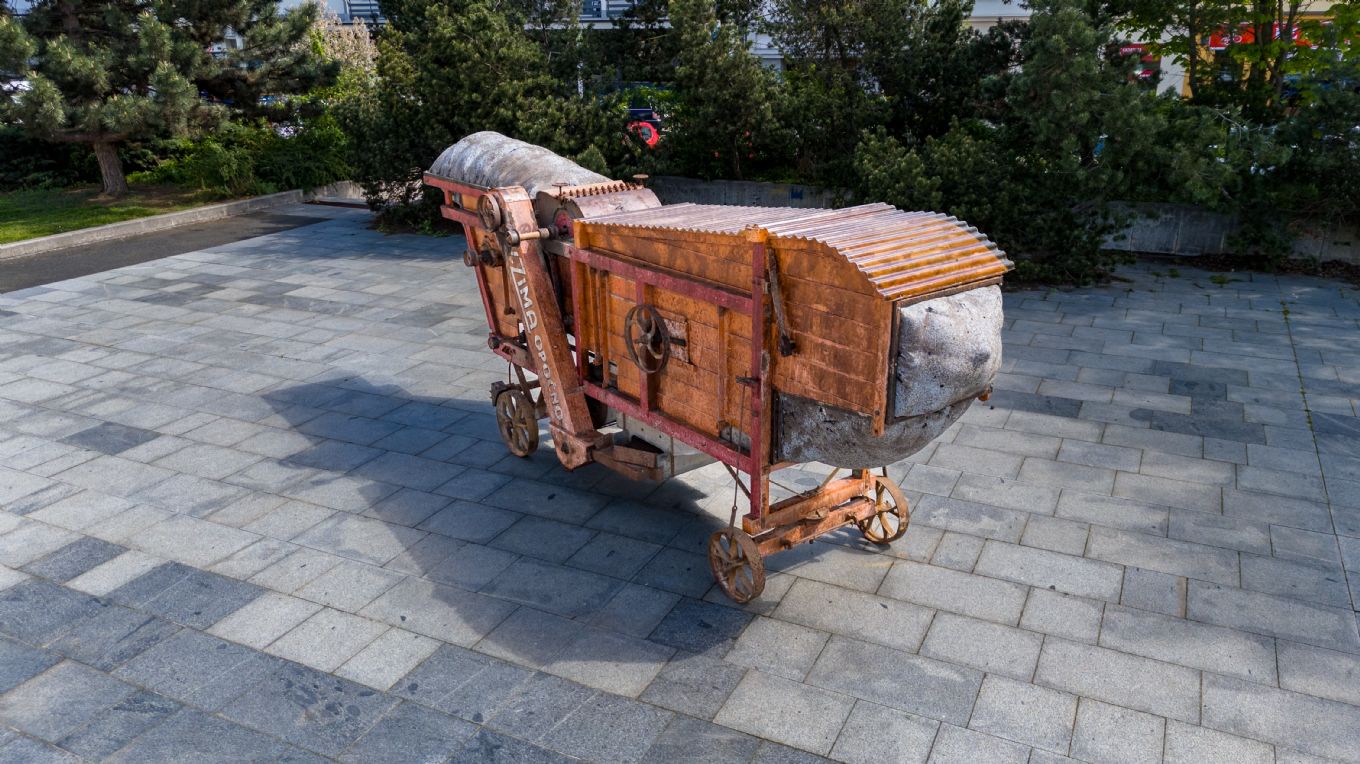
Jiří Kobr (*1974, Dvůr Králové nad Labem) is a Czech sculptor. He studied wood carving at the Secondary School and College of Industrial Arts in Prague in 1988–1997 and sculpture restoration (prof. Petr Siegl) and sculpture (prof. Jindřich Zeithamml) at the Academy of Fine Arts in 1997–2003. His graduation work Cross earned him the Rector’s Award. In his art, he draws primarily on his wood-carving practice and his experience from restoring church furnishings. His deepest sources of inspiration are ancient art, everyday life, and Christian tradition, which inspires him to seek out different forms of expression. Kobr sees work with material as a unique chance for learning, as an important tool for understanding the real world and its real dimensions. He also works with graphics, in particular color woodcuts. In 2002–2005, he taught wood carving and modeling at Prague’s Secondary School of Applied Art. Jiří Kobr lives and works in Hostim near Beroun.
The exhibited work is a figural composition with architectural elements composed into an open space. Its inspiration from Gothic forms is reflected in the sculpture’s placement close to the Church of the Virgin Mary, with which it engages in a formal and semantic dialogue. On the conceptual level, the sculpture is a visual representation of cathartic satisfaction, emphasized by the work’s verticality and further accentuated by the viewer’s movement around it. With some exaggeration, Coronation can be said to symbolize existential thought and true emotion, as expressed by the figures’ rational physicality and the deeply spiritual act of coronation.
5. Coronation, 2024, wood
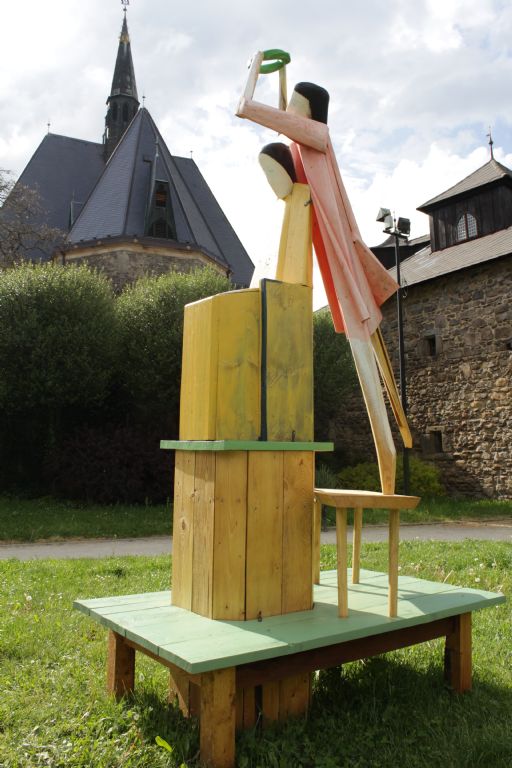
Petra Pešková (*1988, Uherské Hradiště)is a Czech sculptor. She studied stonemasonry at the Secondary School of Applied Art in Uherské Hradiště in 2004–2008, and subsequently attended professor Jindřich Zeithamml’s Sculpture 2 studio at Prague’s Academy of Fine Arts in 2009–2015, winning the school’s Studio Award in 2011 and 2015. She spent 2008–2009 on a study exchange at the Akademie der Bildenden Künste in Munich. In her sculptural work, Pešková recounts stories, events, and situations, often through the use of geometric composition, though her works are never pure formal abstractions. She combines her motifs – the landscape, water, the earth, light – with human themes and the need to remember the natural side of things, something that is being lost in today’s rational world. She has attended sculpture symposia and shown her work at group and solo exhibitions since 2004. In 2014, she installed Funnels on Prague’s Vítkov Hill, and in 2016 she showed Us 2 in the German town of Selb. Pešková lives and works in the village of Milešov.
In Klatovy, Petra Pešková is showing two geometric reliefs depicting the two most important heavenly bodies in our sky, the Sun and the Moon. They are placed on either side of an opening in the city’s historical fortifications between Jiráskova Street at Hostašovy Sady park. The viewer thus can never see both works at the same time, just like the real Sun and Moon, one of which rules the sky at day, the other at night.
6. Sun and Moon, 2024, colored artificial stone

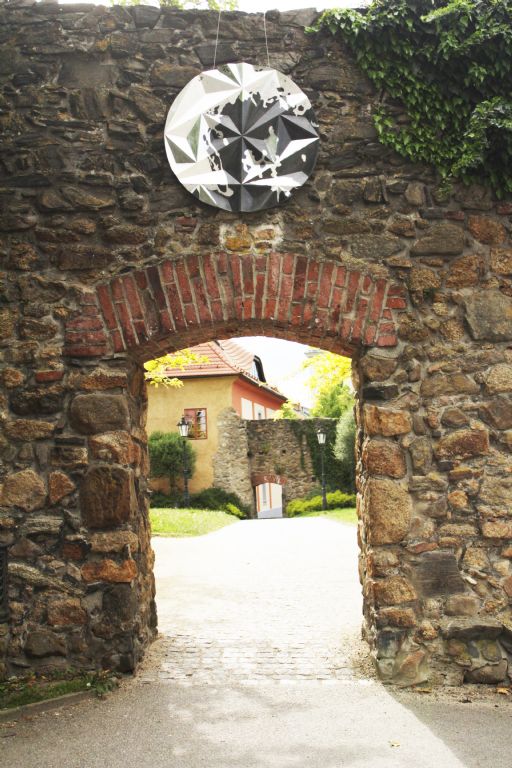
Jakub Lipavský (*1976, Prague) is a Czech sculptor. He attended professor Zeithamml’s Sculpture 2 studio at Prague’s Academy of Fine Arts in 1998–2004, during which time he did study exchanges in Vladimír Skrepl’s painting studio at the Academy and also at the Staatliche Akademie der Bildenden Künste in Stuttgart. Lipavský sees the work of art as an entirely autonomous affair, the point of which is to use its visual impact to evoke a particular effect, to express a certain feeling. His sculptural works are often visually modest, characterized by self-contained perfection and the use of simple elementary forms thanks to which the viewer experiences a kind of ritual calmness emanating from their expressive objectivity. Lipavský imbues this simplicity of form with his own sensory impressions, usually significantly influenced by his surroundings. The manner by which he transforms external reality into art reflects Lipavský’s interest in the reestablished meaning of form and its transformation into a timeless expression. Thanks to the key role played by the material, in his hands a sculpture can be a kind of reconciliation between culture and nature.Lipavský has participated in numerous group and solo exhibitions since 2004; he lives and works in Litovel.
One important aspect of Jakub Lipavský’s outdoor works is their incorporation into the surroundings – in terms of both and shape – to the point that they disappear into them. Lipavský is interested in how sculptures act on their environment, especially in the urban context, how they influence space, and conversely also how climatic influences and human interventions (including vandalism) affect a sculpture. In this sense, he sees his work as responding to the conflict between nature and culture generally.
7. Untitled, 2024, iron, concrete
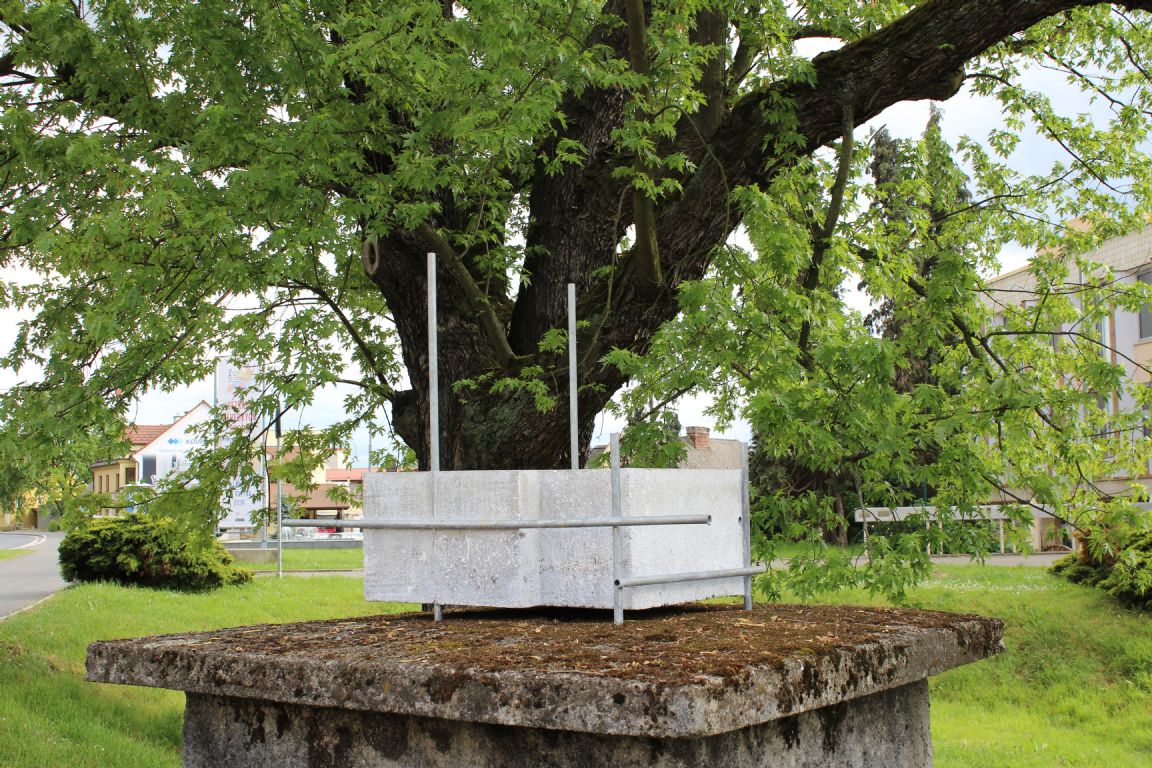
Luděk Míšek (*1976, Pilsen) is a Czech sculptor and teacher.After attending the Secondary School of Ceramics in Bechyně 1991–1995, he continued his studies at Prague’s Academy of Fine Arts in 1996–2003, where he studied in prof. Jindřich Zeithamml’s Sculpture 2 studio. He did a foreign study exchange at the Staatliche Akademie der Bildenden Künste in Stuttgart in 1999–2000 and an intra-school exchange at his home academy’s School of Architecture in 2000–2001 (prof. Emil Přikryl). In 2017, he earned the title of associate professor from the Academy of Fine Arts. Míšek has a longtime interest in the contemporary applicability of classical sculptural techniques for producing elementary geometric forms. Besides creating several works for the public space, he has held numerous solo exhibitions and participated in numerous sculpture symposia since 2004. He is also a member of Umělecká Beseda and the Club of Concretists. Míšek has taught sculpture at University of West Bohemia’s Ladislav Sutnar Faculty of Design and Art since 2010; he lives and works in Chrást near Pilsen.
For Sculptures in the Streets, Luděk Míšek has contributed a public sculpture with a utilitarian function – a wooden monolith that people can sit or lie on and thus physically perceive the great mass of wood as it absorbs the sun, warmth, cold, and other natural elements. Visitors to Hostašovy Sady park, where the work has been placed, will almost certainly appreciate it.
8. Rest Area, 2023, wood
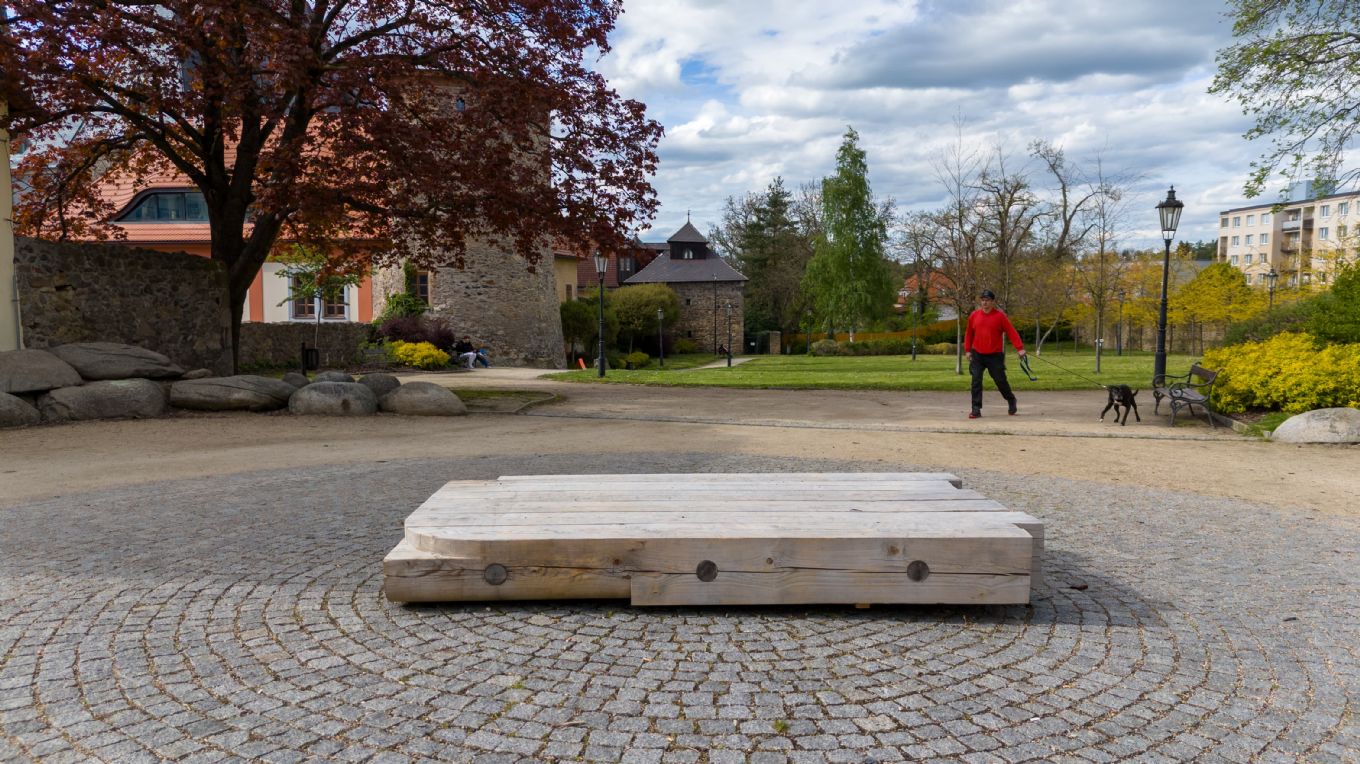
Lucie Píštělková (*1977, Brno) is a Czech sculptor and fashion designer. After attending the Secondary School of Management and Services in Písek in 1992–1996, she studied stonemasonry at the Saint Agnes Secondary School of Applied Art in Český Krumlov in 1997–2001. Later, in 2004–2010, she studied sculpture under professors Jan Koblasa, Jaroslav Róna, and Jindřich Zeithamml at the Academy of Fine Arts in Prague, during which time she did a study exchange at the Bezalel Academy of Arts and Design in Jerusalem. Píštělkováhas participated in group and solo exhibitions in the Czech Republic, Germany, Slovakia, and Israel since 2004. In 2007, her sculpture In Motion earned her an award from the Saxon town of Markneukirchen in Germany. She currently designs and produces clothing inspired by abstract art under the original label abstraktUM. Píštělkoválives and works in Rudice.
At the Klatovy exhibition, Lucie Píštělkováis showing a clothing collection inspired by op art, a form of abstract art that emerged in the 1960s. Works of op art depict neither the physical world nor the artist’s emotions; instead, their main purpose is to create optical illusions based on evoking a sense of motion within the artwork. To this end, op artists make use of the formal vocabulary of lines and shapes and the interaction between various colors. In Klatovy, Píštělková’s clothing designs are displayed on a mannequin located inside an iconic work of contemporary architecture – a glass connecting walkway between the Jesuit College and the Jesuit Gymnázium on Balbínova Street designed by world-renowned architect Eva Jiřičná.
9. Clothing inspired by op art, 2024, sewn fabrics, 100% cotton weave

Lucie Procházková (*1984, Domažlice) is a Czech sculptor. After studying stonemasonry at the Zámeček Secondary School of Applied Art in Pilsen in 2000–2004, she attended professor Jindřich Zeithamml’s Sculpture 2 studio at Prague’s Academy of Fine Arts in 2004–2010. In 2008, she did a study exchange at the Bezalel Academy of Arts and Design in Jerusalem. In her work, made on the basis of personal experiences and their anchoring in the surrounding space, she has long focused on finding a balance in all aspects of life. Her use of a consciously abstract approach often produces a sense of tension that disrupts the geometric figures in the form of a different material detail, the use of text, or an animalistically intuitive intervention. She attended her first sculpture symposium in 2002, and has showed her work at group and solo exhibitions since 2004. Procházková worked as a collections administrator at the Hradec Králové Gallery of Modern Art in 2014–2018, and has taught at the Secondary Technical School of Sculpture and Stonemasonry in Hořice since 2023. She lives and works in Pardubice.
Lucie Procházková’s contribution to this exhibition is a sculptural composition consisting of three vertical cuboid-shaped stone pillars. As the title indicates, they represent the linear trajectory of three symbolic stops on a personal journey. It is a journey full of discovery and freedom, but above all one of reconciliation imbued with a recognition of the basic meanings of existence as the building blocks for the shared values of family and the related sense of safety and protection. The simple, archetypal shape and chosen material are an easily understood metaphor comprehensible across a wide range of societies, religions, and historical connotations. The pillar, like its rectangular base, inherently amplifies its potential as a structural unit of architecture – stone, brick, column, beam. The use of modulation and multiplication creates a dwelling that provides the conditions for creating a home, for preserving memories and sharing them across generations in the form of personal and collective memory. The piece has been installed in Pod Valy park near a busy intersection – a location in which its symbolic identity as a signpost and way marker is further emphasized.
10. Pilsen–Sarajevo–Jerusalem, 2010, mixed media, trachyte, lead, gold
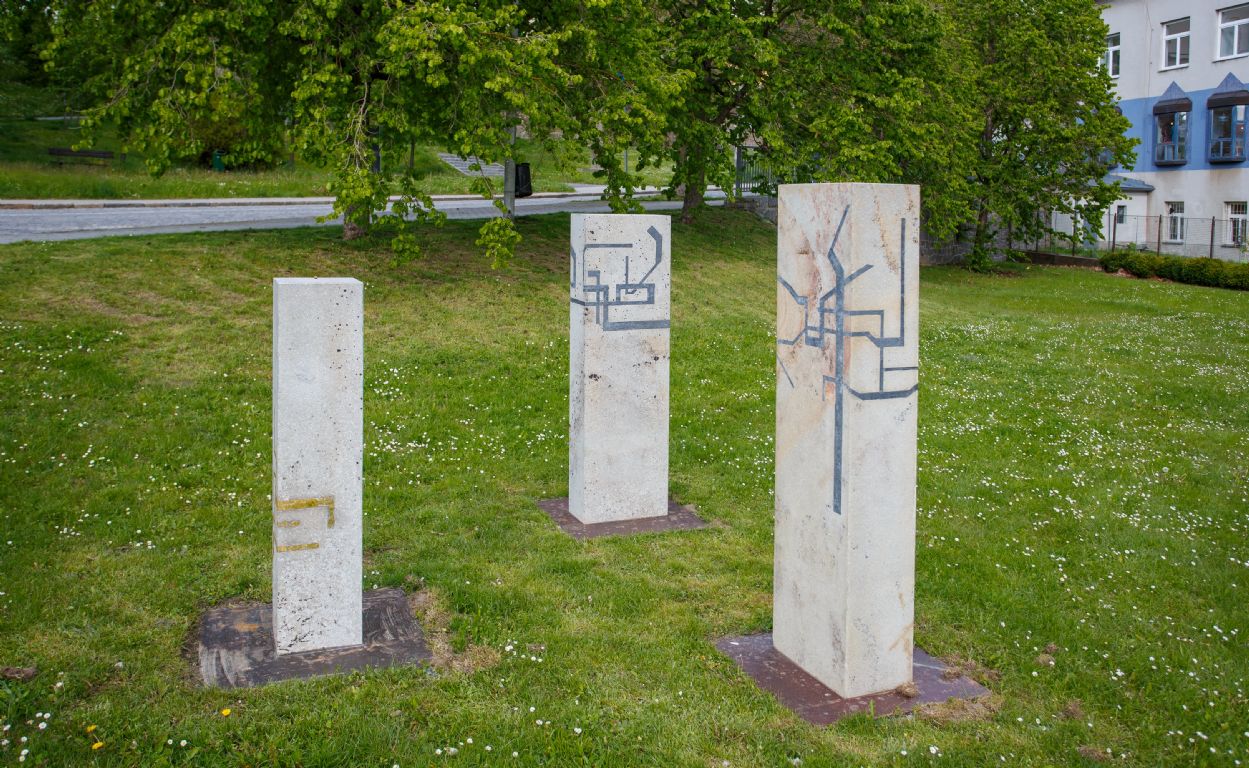
Jindřich Zeithamml (*1949, Teplice) attended various secondary schools (the Secondary Technical School of Sculpture and Stonemasonry in Hořice and the Secondary School of Applied Art in Prague-Žižkov) and spent one year at Prague’s Academy of Fine Arts before working as a stonemason on Charles Bridge. He subsequently worked as a freelance artist before emigrating to Germany in 1972, where he studied under professor Norbert Kricke at the Staatliche Kunstakademie in Düsseldorf in 1976–1982. In the late 1970s, he began creating his oval polychromed objects and objects resembling open boxes or treasure chests. He later came to broader attention thanks to his minimalist geometric sculptures characterized by an almost surprising simplicity of form and covered in paint, gold leaf, or silver leaf, along which the light glides evocatively to accentuate their shape. Zeitmhamml works with a variety of elementary shapes inspired by basic geometric figures such as the square, the circle, the oval, or the sphere – the latter often split into two hemispheres. His work is a sensitive manifestation of a harmonious and animated artistic style. In his reduction of form, he reaches the very limits of abstraction, tending toward a pure spirituality. His stylization of basic shapes is guided by their dematerialization and allows for a metaphysical effect. Zeithamml has been honored with numerous awards for his work. He showed his work to the Czech public after returning to his home country in the 1990s, and in 1995 he was made a professor at Prague’s Academy of Fine Arts, where he headed the Sculpture 2 studio until 2016. A member of the Umělecká Beseda and the Deutscher Künstlerbund, Zeithamml has been exhibiting since 1980. He lives and works in the village of Radouš.
Jindřich Zeithamml’s sculptures, characterized by a precise and subtle modeling, stand in direct contrast with today’s hectic and chaotic life. Their softly flowing volumes are the result of the complex objectifying processes that emerge as he works on his pieces. The same consistent qualities can be found in the new piece he created specifically for the corner of Plánická and Krameriova streets, where it is placed directly across from the Church of St. Lawrence.
11. Large Still-Life, 2024, composite material
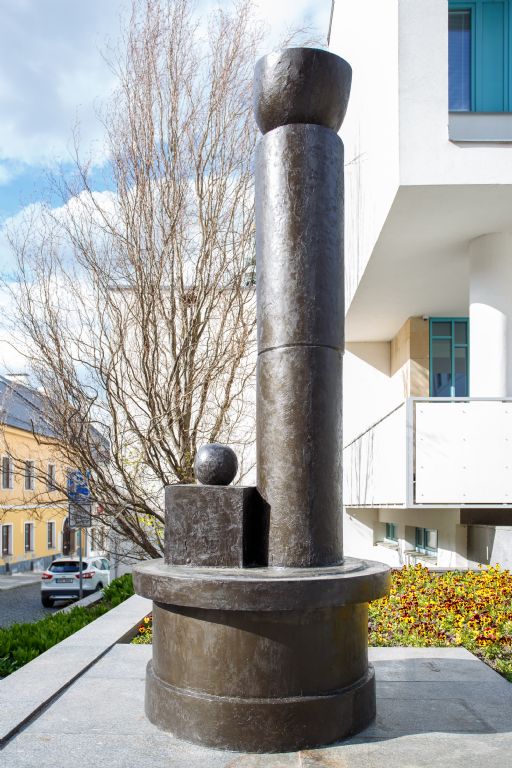
(sources: abart, artlist, Gustav Erhart, Iva Mladičová, Lucie B. Šiklová, wikipedia, archives of the artists)


 Česky
Česky
